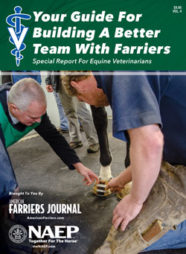This article is a follow up to a print article, "Farrier Q&A: December 2016," which asked farriers, "What’s the best hoof-care tip you received this year?" The article can be read here.
A: Vern Dryden's article on how to shoe horses with synthetic footing and Renate Weller’s article on why equine bones break and tendons rupture. These articles open up a lot to talk about because more and more horse owners are using synthetic footing and the horses are having problems.
When you discuss it with the owners, they often are offended. It would be great to have more research on those things and how they influence the horses’ long-term soundness.
— Scott Chandler, Ocala, Fla.
A: Being an old business guy, I suggest that farriers take a moment to chat with their customers. It's amazing how a couple of minutes invested in conversation will help cement a good working relationship.
— Bill Kirkpatrick, Unionville, Pa.
A: If your horse loses shoes on the fronts, take a closer look at the hinds — the problem might be there. To get the horse in balance, you might have to modify the shoes (support, extension, etc.).
— Klaus Wolfram, Asturias, Spain
A: If you want to cure thrush, nothing works better than soap, water and a brush every day.
— Chuck Milne, Kennedale, Texas
A: Keratex Hoof Hardener for my recently barefoot off-the-track Thouroughbred. She was able to work sound shortly after we started using it.
— Kalli Norton, Little Rock, S.C.
A: Be proactive in what you see:
- Don’t allow the client to reverse your work due to their procrastination.
- Shorter time frames for trims and resets will keep you ahead of problems. Consider heat, humidity, nutrition and environmental factors.
- Using a team approach with digital X-rays puts education and the treatment plan No. 1.
- Be up front. I know from experience that realignment takes at least three resets to achieve the mechanical goal and I communicate that to the client.
- Finish the treatment plan. Follow up X-rays and maintainenance.
— Roger Newman, Somerset, Wis.
A: When it started to get real rainy here, I tried some of the new WD-40 silicone formula on my rasps to prevent rust. Not only did it prevent rust, it also doubled the life of the rasp.
— Heidi S. Larrabee Palmer, Alaska
A: When building shoe heels, use the round face of your hammer. You're less likely to make fish lips. Thank you Jennifer Horn!
— Rick Shepherd, Fort Fairfield, Maine
A: Don’t try to make the feet all look the same and education is always No.1. I have been shoeing horses for 15 years and I always go back to my basics. That is the principle behind every horse that I shoe — strong-minded basics and always having my head in a book or scientific journals.
Farriers look at the horse as a whole and our clientele always look at their feet and wonder why the hooves don’t match. In research I have done, each hoof is going to be its own case. Going slow and really observing each hoof will help set the horse up for success no matter what it’s doing or at what level. Chris Gregory instills that principle — look at the hoof you’re shoeing and then move on to the next hoof.
Education is the highest priority in our profession. We must seek out educational opportunities and grow with our industry. Educating our clients on hoof care also will help our industry and profession.
I seek out education on a minute-to-minute daily routine — I love to see new techniques and love challenging myself. Michael Wildenstein and Grant Moon make shoeing horses look effortless because of strong basics, really going through each hoof and evaluating the hoof with respect to conformation.
— Kyle Carson, Ragley, La.
A: In regard to barefoot trims, I've learned that less is better. Try not to pare out the sole too much and leave enough hoof wall for the horse to walk on. Removing too much wall and sole is counterproductive. Don't forget medial and lateral balance, hoof axis and angle.
— Paul Fields, Waller, Texas
A: Willie Johnson and I have been looking for a treatment for white line disease for several years and a fellow farrier down in Louisiana told us about a remedy he’s been using for several years. It’s a mixture of magna paste and copper sulfate and we found it worked on every horse that we used it on. Our buddy calls it “B-Gone,” cause the white line is gone after it’s used.
— John Halko, Jasper, Ga.






